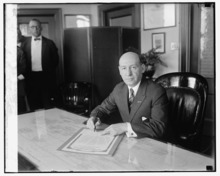Frank T. Hines
| Frank Hines | |
|---|---|
 |
|
| United States Ambassador to Panama | |
|
In office November 1, 1945 – February 20, 1948 |
|
| President | Harry Truman |
| Preceded by | Avra Warren |
| Succeeded by | Monnett Davis |
| Administrator of Veterans Affairs | |
|
In office July 21, 1930 – August 15, 1945 |
|
| President |
Herbert Hoover Franklin Roosevelt Harry Truman |
| Preceded by | Position established |
| Succeeded by | Omar Bradley |
| Director of the Veterans Bureau | |
|
In office March 2, 1923 – July 21, 1930 |
|
| President |
Warren Harding Calvin Coolidge Herbert Hoover |
| Preceded by | Charles Forbes |
| Succeeded by | Position abolished |
| Personal details | |
| Born |
April 11, 1879 Salt Lake City, Utah, U.S. |
| Died | April 3, 1960 (aged 80) Washington, D.C., U.S. |
| Education | Utah State University, Logan |
| Military service | |
| Allegiance |
|
| Service/branch |
|
| Years of service | 1898–1920 |
| Rank |
|
| Battles/wars |
Spanish-American War World War I |
Frank Thomas Hines (April 11, 1879 – April 3, 1960) was a United States military officer and head of the U.S. Veterans Bureau (later Veteran's Administration) from 1923 to 1945. Hines took over as head of the Veterans Bureau after a series of scandals discredited the agency. He was considered a "man of stern honesty." In response to the scandals, the field service was "centralized to establish strict controls and accountability."
Hines was born in Salt Lake City, Utah Territory, on April 11, 1879. He graduated from high school in Salt Lake City in 1896, and worked at the mines in Mercur. He studied engineering at the Utah State Agricultural College for two years before deciding on a military career.
He joined the Utah Light Artillery in 1898 and served in the United States military during the Spanish–American War, becoming a second lieutenant. He was a captain by World War I, was promoted three times in 1918, and as a brigadier general served as chief of the Embarkation Service with responsibility for transporting more than 2 million soldiers to Europe in 18 months and shipping them home in 8 months.
He retired from the army in 1920 and became president of the Baltic Steamship Company.
Hines served as the administrator of the Veterans Bureau from his appointment by President Harding in 1923 to 1930, then as the first administrator of its successor, the Veteran's Administration, from 1930 to 1945, when President Truman replaced him with Gen. Omar Bradley.
He opposed the payment of the Veterans Bonus to World War I veterans. On April 26, 1932, during the hearings on Payment of Adjusted-Compensation Certificates before the House Committee on Ways and Means he testified: that the trust fund had already been nearly exhausted by the previous year’s act increasing the loan restriction on adjusted compensation accounts to 50%; that full payment now would cost the Government $1,600,000,000; and that in any case the accounts represented the only assets many veterans possessed, leaving nothing to families if the veteran should die. “We should make every possible effort to see that they get employment. There is no question about that. But whether we would be doing the veterans a real service by cashing in these certificates, even if we were in a position to do it, would seem to me very doubtful.”
...
Wikipedia
